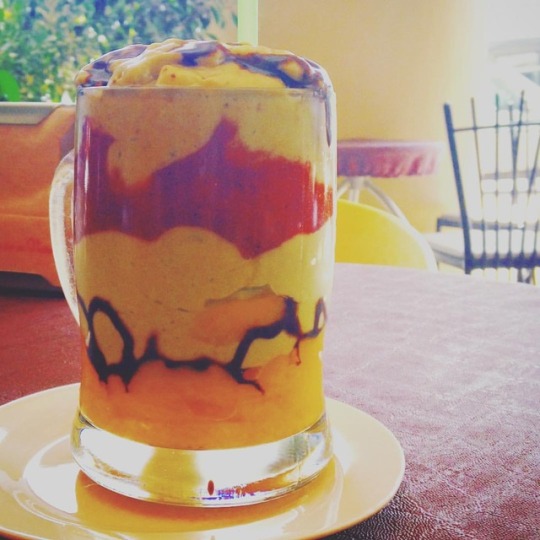Text
little wondrous things: غريبة
Ghraybeh aka "Little Wondrous Thing": What does a perfect shortbread cookie have to do with women's history in the Arabic-speaking world? Recipe, some serving ideas, & a dash of history.
My favorite thing about this cookie is that it’s a sweet, bite-sized Arabic lesson: it’s spelled the same in every country in formal Arabic (fus7a/العربية الفصحى) and it’s a nice example of a diminutive form (a “little” so-and-so). But it’s vowelled and pronounced differently depending on where you are: in the Sham it’s ghray-beh, in Egypt gho-ray-e-ba, in Morocco ghriy-ba. They all refer to the…
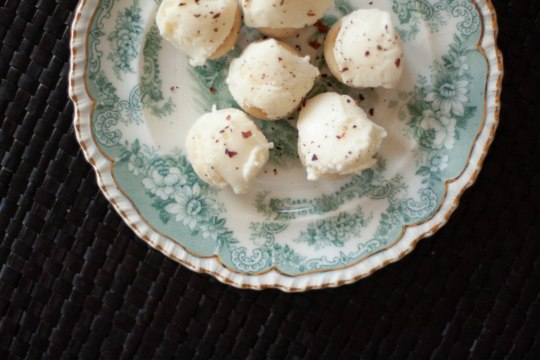
View On WordPress
#Baking#cookie#cookies#egyptian#food history#ghee#ghorayeba#ghraybeh#ghriba#Levantine#moroccan#samna#shortbread#women&039;s history
1 note
·
View note
Text
Tasbikassoulet: French stew, Egyptian technique
French stew, Egyptian technique: in which tasbika, a tomato-based cooking method, lends depth and richness to a vegetarian version of the French classic bean stew cassoulet. #recipe #FoodHistory #tasbika #EgyptianCuisine
The persistent prestige of French cuisine in today’s food cultures is hard to ignore. Even as the range of what food critics and gourmands deem “good food” expands, the dominance of French techniques and aesthetics remains baked into the system. French methods and principles still dominate most of the world’s culinary schools and organize labor in the kitchens of countless restaurants.
I see…

View On WordPress
#arugula#bean stew#butternut squash#cassoulet#clarified butter#culinary experiments#Egyptian cuisine#food history#French cooking#ghee#Paula Wolfert#tasbika#tomato stew#tomatoes#vegetarian
0 notes
Text
tart, bright, sweet: cooking with Anas Atassi's Sumac
tart, bright, & sweet: cooking with Anas Atassi's cookbook Sumac
At the end of 2021 I had the privilege of interviewing Anas Atassi, author of Sumac: Recipes and Stories from Syria, for Radical Books Collective event titled “Gastropolitics, Gastropoetics.” The event featured a range of speakers and books asking what it means to take cookbooks and recipes seriously as political texts, with authors speaking to Somali, Afghan, and Syrian food, among others.
You…

View On WordPress
0 notes
Text
making levantine cuisine: a new book (with recipes)
Making Levantine Cuisine: a new book that explores the history & culture of modern Levantine foodways through scholarship, narrative, and recipes
It’s been a while, but here I am. It feels like an especially dark solstice amidst a dark plague year, but I’m hoping to return to regular posting to share some spots of brightness. First up: a book that I helped co-edit, which has just been published: Making Levantine Cuisine.
It’s my first foray into academic book publishing, and I’m particularly excited to share it here because this book is…

View On WordPress
#culinary ethnography#food history#gaza#Gazan cuisine#levantine cuisine#mezze#rice pudding#Shami food#shrimp
5 notes
·
View notes
Text
koshari: the original flexitarian grain bowl
koshari: the original flexitarian grain bowl
I ate my first bowl of koshari in 2013, and ever since I’ve been collecting bits and pieces of its eclectic history. Earlier this year, with Cairo standby Zoobaopening a branch in New York and as my dissertation-to-book research began to inch forward, I decided it was time to write up what I’d learned so far––cobbling together meals mentioned in travelogues, discussions of koshari in a dozen oral…
View On WordPress
#Egyptian food#Egyptian food history#grain bowls#hot pepper#koshari#koshary#lentils#pantry cooking#pulses#quarantine cooking#rice#shatta#tomato sauce#vinegar#Zooba
0 notes
Text
I have been baking a lot lately (I know, how original). Usually this means I’m making either my run-of-the-mill sourdough loaf (following this excellent primer from the Kitchn) or this evergreen Smitten Kitchen buckle, swapping in whatever fruits are in season –– it is a particularly great way to use up the sad apples at the bottom of your fridge –– and substituting different spices based on pairings I find in Niki Segnit’s indispensable The Flavor Thesaurus. This week was a pear & blueberry buckle with cardamom and ginger.
Lately though, because I am only eating bread I make at home, my container of sourdough discard (a yeasty mix of flour and water that I add to whenever I feed my active starter) is growing by the day and I thought I would try something new. And so recently in preparation for an appearance on Tony Tahhan‘s wonderful #TetaThursdays Instagram Live series, I set about experimenting with techniques and recipes for making khobz ʿarabi (literally, Arabic bread, aka pita bread) using only discarded sourdough as the leavening agent.
If you are longing for fresh khobz ʿarabi and have some sourdough discard handy, this is the recipe for you! No yeast required; recipe & details after the jump. (I’m still working on capturing great images of this recipe, but in the meantime enjoy this gorgeous shot from Tony’s IG page!)
View this post on Instagram
A post shared by Antonio Tahhan طوني طحّان (@antoniotahhan) on May 9, 2020 at 3:26pm PDT
Sourdough Khobz ʿArabi
Ingredients:
For eight round loaves
120 grams warm water
240 grams sourdough starter discard
360 grams bread flour
1 tablespoon olive oil
1 teaspoon salt
A few notes
My starter is made with wheat flour, so I kept the rest of the flour mix white. Each time I did this, I was using starter that had been fed in the past week or two, but was not especially fresh. In terms of how hot the water should be, I aim for a temperature that is not too hot to the touch on the back of your hand for ten seconds, but then feels too hot after that time. It’s a rule I learned when I first starting baking on a NOLS course 15 years ago and it’s never steered me wrong.
Directions
1. Mix all ingredients together in a mixing bowl until a shaggy dough forms. Transfer to a stand mixer and mix with the dough hook for 10 minutes. You can also knead by hand; the goal is to get your dough to pass the “windowpane test.” This is essential to ensuring that once the bread bakes and cools it holds together without cracking or breaking apart (pictured below: the chewy consistency we’re going for!).
2. Cover the bowl with plastic wrap or a damp towel and let it rise 6-8 hours (the dough should double in size).
3. Divide into eight pieces and roll them lightly into balls. At this point you can either dust them with flour and tuck them away in the fridge for up to 3 days, or you can simply cover them with a damp clean towel and let them rest for an hour.
The fridge technique develops the flavor and texture and also makes the loaves slightly easier to handle when you roll them out. But you can do without! If you are storing in the fridge, you can wrap them individually in plastic wrap or bags, or nestle each ball of dough in a muffin pan then cover the whole thing with plastic. If you have chilled the dough in the fridge, let it rest for an hour or two at room temperature, covered to keep it from drying out, before moving to the next step.
4. Roll the balls of dough into thin rounds (lightly dusting the surface you’re working on helps). This is, for me, the hardest part. You really want the dough to be flat (no thicker than a quarter inch) and as even as possible. For me this was the step that was trickiest (and least successful) when I began and started to improve after I worked through several batches; it’s one of those things best learned by doing. I used a combination of flattening gently by hand and then finishing with a rolling pin, trying not to handle the dough too much to leave it as even and intact as possible.
5. Once rolled out, let the rounds sit, covered again with a clean damp towel, for another hour or two. Meanwhile preheat your oven as high as it can go, aiming for somewhere around 550 degrees F. Preheat a baking surface along with the oven: you can use a baking tray/cookie sheet for this, but my best results have been with a cast iron pan. I have heard pizza stones work well too, though I don’t own one.
6. Once your rounds are rested and the oven preheated, place them one at a time on your baking surface, turning over each one so that the side that was resting face down on the countertop is face up in the oven. This is a tip I heard from numerous experienced bakers and I think it does make a difference.
The bread is finished when it puffs up into a pocket. For me this generally takes only between 60 and 90 seconds, so keep an eye on it! Wait until it has fully inflated before removing it from the oven.
7. Once the bread is done baking, wrap it in a clean dry towel placed on a cooling rack. You can stack the loaves together. Cooling this way helps keep them from drying out.
A bit about process & rationale
Most sourdough recipes for khobz ʿarabi or pita bread either call for commercial yeast or for very fresh, bubbly starter, so my goal here was to develop a recipe that didn’t require yeast (hard to find these days) and could function with only leftover/discarded starter as a leavening agent. My main tasks were to develop a recipe for the dough and then to learn as much of the technique as possible for preparing and baking it.
I began with this recipe to get a sense of rough proportions, and it turned out ok but not spectacular: the finished loaves were prone to breakage, didn’t always puff up in the beautiful pocketed form I was hoping for, and didn’t always retain a nice chewy texture upon cooling. But it was a good starting place in terms of ratios and I adjusted from there.
View this post on Instagram
Introducing Umm Kulthum (أم كلثوم), my sourdough starter #ifyouknowyouknow Swipe right for the time-lapse! . . * Thanks @madebysaba for the AMAZING illustration! * Thanks @loaf_bakehouse for the sourdough starter tutorial! * Thanks @razan_graphics for the beautiful artwork inspiration!
A post shared by Antonio Tahhan طوني طحّان (@antoniotahhan) on Apr 20, 2020 at 5:52pm PDT
On advice from Tony, who was also working on recipes (along with his starter Umm Kulthum, pictured here) and reading up on all the best practices in sourdough, I decided I wanted to work towards a recipe with 1) measurements by weight, in the form of baker’s percentages, and 2) a slightly wetter dough, which should help maximize steam and gluten –– important for that puff of the pocket.
I also really wanted a set of ratios I could remember without writing them down. After a few batches I settled on a recipe by weight that called for one part water to two parts starter to three parts flour (1-2-3!).
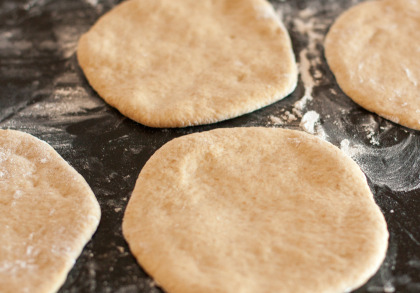
Next was figuring out the little tips and tricks that produce the right kind of bread. This one is not easy –– everything has to be just right for the bread to expand into a pocketed round in the oven and cool off while staying chewy and tasty. Most of my experience with this kind of flatbread was from watching Moroccan bakers make it at home, either in wood burning outdoor ovens or on a griddle, so the physics of this bread were entirely new to me.
I relied heavily on this helpful list of rules and asked for lots of advice from folks who’d made oven-based khobz ‘arabi before (h/t Marya Hannun for her advice!). I also took some great tips about technique from a discussion on my Facebook page (h/t to Tylor Brand for the suggestion about refrigerating the dough), and my mom suggested the muffin tin trick for resting the dough in the fridge.
A few questions I have moving forward and variations I’ll be trying out in the coming days: how much wheat flour is too much? What other flours might work? How does regular white flour compare to bread flour?
Depending on the humidity of the day and timing I also often found my loaves were drying out a bit, so next time around I may experiment with storing and rolling them out with the help of a very light amount of olive oil rather than a dusting of flour.
Thanks to everyone who helped me test drive this bread, and please let me know in the comments if you have any tips, improvements, or questions. A particular thank you to Tony for inviting me to join #TetaThursdays and providing crucial assistance while developing the recipe!
Want to make khobz ʿarabi (aka pita bread) but only have sourdough starter on hand? This recipe is for you! No commercial yeast required. I have been baking a lot lately (I know, how original). Usually this means I'm making either my run-of-the-mill sourdough loaf (following…
0 notes
Text
Since graduating from college I’ve moved, on average, more than once a year. Often this means unpacking my bags and walking into a kitchen with nothing in it except a cup of olive oil and some salt. So I’ve gotten pretty practiced at stocking a pantry and developing a rotation of easy, reliable meals that keep me fed while I figure out where the best produce or spices or specialty markets are for more ambitious cooking activities.
As we all prepare for social distancing measures due to the spread of COVID-19, several friends have reached out asking if I have advice on stocking a pantry while avoiding monotonous cooking. And so I thought I’d finally put together a primer on the lists and meals that I draw on when stocking from scratch. Most of these are one-pot meals and are vegetarian or vegan, because that tends to be how I cook day-to-day.
Below you’ll find a few handy lists for stocking the pantry with non- or semi-perishable items and a week’s worth of recipes that largely draw on those ingredients, requiring only minimal additions of fresh produce. These recipes tend to come together fast and most of them freeze well, meaning you can double the recipe and stash away meals for later, stretching fresh produce for longer. This assumes you’ve already got some spices, oils (or other cooking fats like butter), sugar, and vinegars on hand.
Flexible non-perishable staples
I always try to have at least some of the following in my pantry at all times:
Canned whole tomatoes
Canned crushed tomatoes
Tomato paste
Sun-dried tomatoes
Canned chickpeas
Canned black beans
Canned coconut milk (not sweetened)
Vegetable or chicken stock (either canned, in a carton, or the paste you keep in a jar in the fridge)
Green lentils
Red lentils
Long grain rice
Short grain rice
Several kinds of pasta (a long skinny kind & a penne or rigatoni type at minimum)
A few grain alternatives: I like couscous, freeka (cracked green wheat), and bulgar wheat
Nuts, a variety (currently I’ve got some hazelnuts, slivered almonds, and pumpkin seeds)
Versatile and not-too-perishable items:
Sturdy dark leafy greens (collards, kale, chard) and root vegetables, which tend to last longer in the fridge than other veggies and greens
Variety of fresh herbs: thyme, rosemary, cilantro, dill, and parsley tend to be hardiest, and I find they last longer if snapped away in good tupperware, one per herb. On first use, wash thoroughly, and dry as completely as possible before storing
Onions and garlic. Pantry miracle workers!
Hard and/or salty cheeses last longer: feta, parmesan, pecorino romano, halloumi
Fresh ginger: keep it in the freezer and grate with a microplane
Lemons: these keep for a good long time in the fridge, and the juice & zest freshen up everything
Olives and capers and pickles: designed for preservation and they add a punch to nearly any dish. I love pickled/salted lemons, increasingly available in your Middle East / International food aisles of major grocery stores
Hot sauces & dried hot pepper: the more the merrier! Right now I’ve got a jar of harissa, sriracha, and dried Aleppo pepper on hand
Pomegranate molasses: as important as your standard array of oils and vinegars
Grab some of those shakers typically used for red pepper flakes and dried faux Parmesan and fill them with your favorite spices or seasonings: for me it’s sumac and zaatar. I add one of the two to almost everything I cook and like to have it handy and easily accessible.
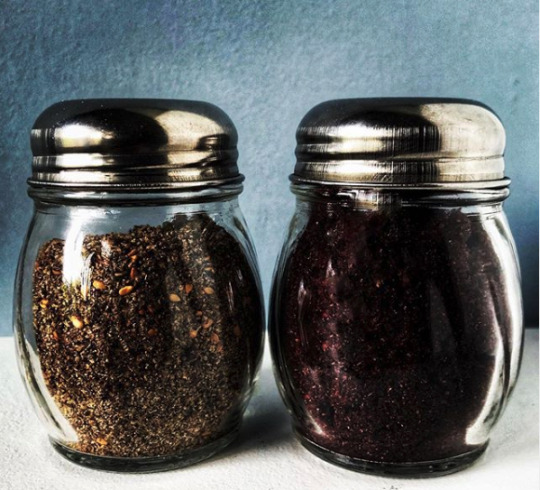
A week’s worth of recipes. Some of these are my own, and others are from some of my very favorite publications and chefs. I’ve included a few notes about my own tweaks and possible substitutions. I always tell my students to “follow the footnotes” and strategically use bibliographies, and the same principle applies here when thinking about expanding your culinary repertoire: it’s always a good tactic to browse elsewhere on the site of a recipe you love or Google the author for more good ideas.
Monday: Pasta with tomato sauce from scratch, Roman style
I learned this from a friend who learned it from her host family in Rome. Even though you can dress it up with other veggies and herbs (as pictured below), all you *really* need is a can of whole tomatoes (chop them and pour in all the liquid they came with too, then as they cook down, use a potato masher to finish the job), olive oil, salt, sugar, garlic, and pasta. The sauce freezes well. Simple and comforting!

Tuesday: Just-keeps-getting-better lentil salad
Via Bon Appetit: it is truly as good as they say. You can make it with any dark leafy greens, any nuts, a bit of chopped onion if you don’t have scallions, and any olives (or even capers in a pinch). And it does keep for days, and keeps getting better.

Wednesday: Eggplant and lentil stew with pomegranate molasses
Originally found on Food & Wine, this is a recipe from Musa Dagdeviren’s wife Zeynap, who’s from Antakya, a region that boasts the best of Turkish and Syrian culinary influences. It’s a set-and-forget dish so you can put it on the stove and watch the delightful Chef’s Table episode about Dagdeviren while it cooks. You can swap out the fresh tomatoes for whole canned ones, meaning the only fresh ingredients you need are eggplants, green chiles, and fresh mint. And even so you can do without the mint and substitute dried chiles if you need to. This freezes well.

Thursday: Braised coconut & chickpeas with lemon
From Faith Durand of the ever-reliable The Kitchn. I typically skip the sweet potato (though it’s delicious if you do wish include it), double the chickpeas (or substitute cannellini beans) and add more hot spice and some chopped preserved lemon. I’ve made it with kale and collards too––just slice them thinly and cover the pot for the first few minutes to speed up the cooking. Freezes well.
Friday: Curried lentil, tomato, and coconut soup
From Yotam Ottolenghi, via Epicurious. This one is truly a wonder: all you need is some fresh herbs (preferably cilantro, but basil and parsley are also nice) and fresh lemons or limes. Everything else is pretty shelf-stable, but it doesn’t taste or look that way in the least. And it freezes well, too.
Instead of the “curry powder” instruction here I use my own spice mix of turmeric, a tiny bit of cumin, powdered ginger, fresh black pepper, and dried coriander.

Saturday: Risotto of any kind
I love risotto. And as long as you have good broth (I make this at the end of a week, once I’ve got a bunch of veggie scraps saved up to make my own broth), any kind of short-grain or even medium-grain rice, and an onion, you can make this and toss in whatever vegetables you have around. The linked recipe outlines the basic principles for the cooking process for risotto (which is not scary or intimidating, and you should try it!). Below: pantry-clearing risotto from a few months ago.

Sunday: Order in
Small businesses, especially local restaurants, are already struggling and it’s only going to get harder in the coming weeks. Treat yourself and support your local restaurant community. Consider supporting a Chinese restaurant in particular! Most if not all delivery apps now offer contact-free drop-off. Just remember to tip well, and in cash if you can.
Need to stock the pantry in preparation for social distancing, but not sure where to start? I've got you covered w/shopping lists & a week's worth of recipes. Since graduating from college I've moved, on average, more than once a year. Often this means unpacking my bags and walking into a kitchen with nothing in it except a cup of olive oil and some salt.
0 notes
Text
The latest edition of Rawi, Egypt’s glossy, impeccably designed heritage review, just came out––and it was all about food. It features articles about everything you’ve ever wanted to know about Egyptian food, from a rare glimpse into the cuisine of rural Egypt to a deep dive into millennia of Egyptian bread history. My own contribution, naturally, was about Abla (“Auntie”) Nazira, aka Nazira Niqula, Egypt’s most famous modern cookbook author (you may recall how I worked through her duck recipe one Thanksgiving a few years ago).
Thanks to the magazine’s incredible design team the article looks beautiful, and it’s a particular privilege to have my work translated into Arabic (the magazine is bilingual). I’m especially grateful to the editors, Yasmine El Dorghamy and Mennat-Allah El Dorry, for tracking down a family photo of Nazira Niqula out to lunch with friends, which appears next to the text.
The issue also includes a recipe for macarona bechamel, the classic Egyptian comfort-food casserole, which I translated from the famous cookbook Abla Nazira co-wrote with Bahiya ʿUthman. You’ll have to track down your own copy or Rawi for that recipe, but when I was testing and translating it last year, I also tried my hand at another iconic Egyptian dish: lentil soup, or shorbat ʿadas. So in honor of the issue’s release, I thought I’d publish my spin on Abla Nazira’s Egyptian lentil soup here.
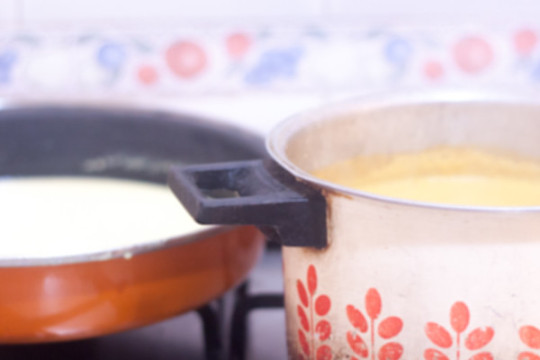
When I was doing “kitchen histories” in Egypt, one of the questions I always asked was about recipes made in different seasons of the year. One of the first responses was always some version of this lentil soup, explained to me as a dish that warms you up and gives you the kind of energy you need in the cold season (and yes, Egypt does get cold!).
Lentils were also cited as a popular comfort food. One family I met explained that according to a local superstition, if a person doesn’t satisfy their cravings during pregnancy, their child will bear a birthmark in the shape of that food. “But of course that’s just something people say,” they reassured me, not something to take to heart. A few minutes later, however, they mentioned a cousin who had been born with a lentil-shaped beauty mark. I showed the family the small birthmark on my own ankle and the mother decided that it was shaped like a piece of chicken.
Niqula & ʿUthman’s recipe is almost startlingly spare for such a beloved dish, but I suspect they knew that many of their readers would already have some version of the recipe in mind, inherited from a mother or grandmother or aunt. So I’ve treated their recipe more like the aide-memoire instructions of earlier Arabic cookbooks and expanded it with the advice of an expert, the dynamic subject of one of my richest oral history interviews who also happens to be a spectacular home cook. I’ve anonymized the interviewees from my academic research, so when I write about this particular home cook, I call her Hanan.
When I asked Hanan how to make lentil soup for winter, she said that beyond the basic lentils + onion combination, one could add tomato, garlic, and or parsley, depending on personal preference. But she strongly advised the addition of carrots. It makes for akla gamila, she explained, using an adjective implying something at once nutritious, tasty to eat, and beautiful to look at.

Homestyle Lentil Soup
HassaʿAdas Baladi
حساء عدس بلدي
Translated and adapted from Usul al-tahi: al-nazari wa-l-ʿamali (Fundamentals of Cooking: Theory and Practice), aka Kitab Abla Nazira, by Nazira Nicola and Bahiya ʿUthman (1941)
In addition to the inclusion of the carrot and Hanan’s direction to puree the soup to a smooth consistency in a blender, I’ve also swapped regular for clarified butter and adapted the measurements for contemporary American usage. I’ve kept Niqula & ʿUthman’s specification that a red onion be used. The lime wedges to serve are my own suggestion, although they would not be out of place at an Egyptian table.
You will need:
2 cups red or yellow lentils
2 liters of your choice of broth
1 teaspoon of salt, plus more to finish
1 medium-sized red onion, chopped
1 medium-sized carrot, chopped
2 tablespoons of butter, divided
French bread, cut into cubes
Salt and cumin to taste
Lime wedges, to serve
Instructions:
Clean and rinse the lentils and place them in a large pot. Cover with an inch of water and add a teaspoon of salt. Bring to a boil then simmer for 5-7 minutes. Strain.
In a skillet, brown the chopped onion and carrot in a tablespoon of butter.
Add the onion, carrot, lentils, and broth to the pot, if using an immersion blender; otherwise, add them all to a regular blender, leaving the buttered skillet as is for now. Blend until smooth.
Return to pot if necessary, then reheat and add salt and cumin to taste. Simmer on low heat for 5 minutes.
Toast the cubes of bread in the buttered skillet; use these as a garnish.

Immediately following this recipe is another for foreign or European (“afranji”) style lentil soup. That recipe is far more elaborate, with potatoes and other vegetables as well as milk. It would be an easy conclusion to jump to that the division of lentil soups, and many other recipes in the cookbook, into categories of “baladi” (local/Egyptian) and “afranji” (foreign/European) is evidence of the existence of discrete Egyptian and local cultures sitting side-by-side in late colonial Egypt. But of course this is a fiction. Consider, for example, the inclusion of croutons made from French-style bread as a garnish for a classic Egyptian soup.
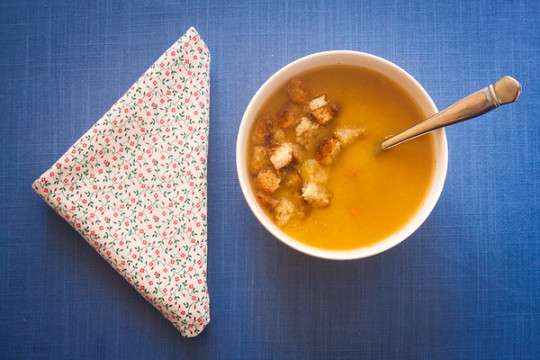
This is partly a reflection of the fact that Western styles of bread were a mark of social status in twentieth-century Egypt, particularly among Niqula & ʿUthman’s social milieu. But it’s also a reminder that food cultures are always hybrid, always evolving and borrowing and adapting. Acknowledging that doesn’t mean we lose sight of histories and roots and origins; but it helps us to take the long view––and hopefully a more expansive view, with room for variation and diversity, rather than purity––in the way we categorize and describe and label the food we eat.
Auntie Nazira's shorbat 'adas: an Egyptian homestyle #lentil #soup #recipe to warm you in winter The latest edition of Rawi, Egypt's glossy, impeccably designed heritage review, just came out––and it was all about food.
#Abla Nazira#archives#bread#butter#carrots#comfort food#cooking history#croutons#cumin#home cooking#lentils#Rawi#Rawi: Egypt&039;s Heritage Review#seasonal eating#soup#winter foods
0 notes
Text
For me, this was the drink of 2019: I made this sweet-and sour mocktail throughout the year for friends in Rabat, Cairo, Washington, and Charlotte.
Developed from and inspired by several different recipes from Scents & Flavors: A Syrian Cookbook (recently translated by Charles Perry & published by NYU, and from which I have cooked several times before), it starts with a base of lemon and pomegranate juices then layers in a few unexpected additions for a subtle complexity.
The impetus for crafting this recipe was to create a complex, interesting, alcohol-free mixed drink to serve at gatherings I was hosting––so that friends and guests who aren’t drinking alcohol for whatever reason would have something interesting to drink. But I quickly learned that with a shot of bourbon or rye, it’s delicious as a cocktail, too. (I suppose if you wanted to keep things geographically consistent, you could always mix in a little Johnnie Walker Black, though personally I prefer a nice Kentucky bourbon in this recipe).
Here, just in time for winter holiday celebrations of all kinds, I present the recipe I’ve honed along with one for a very simple apricot dish also from Scents & Flavors that has become a staple of every mezze spread I’ve made this year. You can find the recipes I used to make up the drink as well as the apricot recipe in Chapter 2 of the book; further drink recipes for inspiration are in Chapter 3.
The major change I’ve introduced into the group of original recipes is the addition of saffron. It’s a floral flavor unlike any other––a bit less delicate than other florals, warm, and subtle––which to my mind makes it perfect for cocktails. I usually introduce it by making my simple syrups with saffron, steeping a pinch of threads in from the start to produce a golden rich liquid. This provides a nice balance to the recipe alongside the very forward floral of orange blossom water and the cutting tang of apple cider vinegar.
Syrian Citrus Mocktail
Loosely based on recipes in Scents & Flavors: A Syrian Cookbook
Proportions are for one batch (2-4 servings, depending on how big a pour you’re planning on. If you are mixing with alcohol, you can stretch this batch to more servings; otherwise it will make a generous amount for two people.
Ingredients:
8 ounces lemon juice, ideally fresh squeezed, no sugar added. I’ve found this is usually somewhere in the ballpark of 4 medium-sized lemons
4 ounces simple syrup with saffron. I make simple syrup with a 1:1 sugar to water ratio, dissolved on low heat, covered, stirred from time to time. Toss in a pinch of saffron, if using, from the start.
2 tablespoons pomegranate molasses
1 tablespoon of orange flower water
Splash of good apple cider vinegar
A few dashes each of powdered cinnamon, nutmeg, and ginger
1 lemon, cut into pieces
1 quince, cut into pieces
1. Combine everything but the spices, cut pieces of lemon, and quince in a saucepan, and test for sweetness.
If you want a little more tang, you can splash in some extra vinegar; and depending on how your lemons and simple syrup match up you may want to add more sugar until it’s the right consistency (the ratios here are just a start; sweetening lemon juice needs to be done so precisely that I almost always adjust a bit one way or another). Always start with less sugar and gradually increase the sweetness rather than the other way around (i learned this important lesson the hard way when attempting to make a very large batch in an industrial kitchen).
2. Next, toss in the spices and slices of quince and lemon. This is a step I wouldn’t have thought of unless the cookbook had suggested something along these lines, and I like to think the addition of the quince gives the final flavor profile something a bit new and different.
3. Brew all these together on very low heat, covered, for 20-30 minutes.
4. Strain the liquid into a new container, squeezing the quince pieces in particular to juice them a bit into the final preparation.
5. Serve warm or serve chilled over ice. You can garnish with mint or pomegranate seeds, depending on the season.
Sweet Cool Apricots (Mishmish)
The anonymous 13th-century author of Scents & Flavors recommended that this recipe be served as a snack with drinks. It’s incredibly simple, but will transform an average dried apricot into a sweet (but not too sweet), perfectly textured delectable delight.
Take a bag of dried apricots. Place them in a bowl with a generous splash of orange flower water and a pinch of saffron, then fill the bowl the rest of the way up with cool water.
Soak them for a few hours (or overnight) then strain and chill.
These are the perfect chewy texture and come out with just a hint of orange blossom & saffron. I recommend pairing the cool apricots with warm sea-salted olive oil-warmed dates, prepared like so, according to Renee Erickson’s brilliant recipe, for a set of perfectly contrasting flavors and textures.
A sweet-and-sour mocktail inspired by thirteenth-century Syrian Scents & Flavors: lemon, pomegranate, orange blossom water, saffron, apple cider vinegar and quince make for a subtle delicious non-alcoholic option for the holidays. For me, this was the drink of 2019: I made this sweet-and sour mocktail throughout the year for friends in Rabat, Cairo, Washington, and Charlotte.
#apricot#cocktail#dates#lemons#mezze#mishmish#mixed drink#mocktail#orange flower water#pomegranate#pomegranate juice#quince#saffron#Scents and Flavors
0 notes
Text
translating hummus
In which I outline a historical grammar of hummus that explains why dessert hummus is so bad and why it matters. #foodhistory #historicalrecipes #hummus
It’s been happening again.
I want to cry pic.twitter.com/vrL3vDHBd4
— Liana Aghajanian (@LianaAgh) October 2, 2019
Over the past several weeks, in various corners of my social media world, there has been an uptick in posts about the latest deplorable concoction that someone is passing off as “hummus.” From a “cake batter” hummus I glimpsed on Facebook to this tweet of CBD and Hemp Hummus, my…
View On WordPress
#cinnamon#cold salads#cookbooks#cultural appropriation#Egypt#food history#historical recipes#hummus#lemon#lemon juice#Lilia Zaouali#medieval Arabic cookery#mint#pickled lemon#pomegranate#pomegranate molasses#preserved lemon#recipes#sesame#tahini#translation#walnuts
0 notes
Text
salted lemon hummus, for tastes medieval and modern
salted lemon #hummus, for tastes medieval and modern: a historical #recipe for contemporary tastes #foodstudies #historicalrecipes #cookinghistory
Earlier this year I wrote an essay for The Recipes Project about the forerunners to today’s hummus, based on a group of recipes in a fourteenth-century Egyptian cookbook– recently brilliantly edited and translated by Nawal Nasrallah. As I worked on that essay, I tried my hand at a handful of those recipes and at long last, I am presenting my adaptations of those recipes here! Below is an…
View On WordPress
#cairo#caraway#chickpeas#cooking history#coriander#food history#hummus#medieval Arabic cookery#mint#Nawal Nasrallah#olive oil#pistachio#preserved lemon#tahini#vinegar#walnuts
2 notes
·
View notes
Text
This is a follow-up to a couple of posts: it revises an Egyptian duck recipe I posted several years ago and it’s the sequel to the classical Arabic duck recipe from last December. If that was a classical Arabic sort of duck, this is its vernacular counterpart. In my academic writing lately, I’ve been using both recipes to think through the differences between written recipes and the those handed down or shared in other ways.
More on that, and a recipe for a slightly tart, slightly sweet, entirely sumptuous roast duck recipe, below.
This recipe is a composite of several different recipes, starting with this one that my roommate and I attempted in Cairo several years ago and updated over the course of many hours spent talking, cooking, and eating with some of Egypt’s best home cooks.
The recipe is also a microcosm of Egyptian food history. It’s seasoned with cardamom and mastika (both pictured above; mastika is also called mastic gum or gum Arabic), a combination that many Egyptian women I’ve met identify as characteristic of their grandmother’s cooking. The bird is cooked with citrus – which, according to Nawal Nasrallah, was a common practice in medieval Egypt. Nasrallah also notes that mastic has long been used in Egyptian cooking to offset the strong odors of meat and poultry, the same features that ʿUthman and Niqula were so concerned about countering with their 1941 duck recipe. This particular use of mastic is a uniquely Egyptian phenomenon in a region where the spice is typically used to flavor sweets and confections.
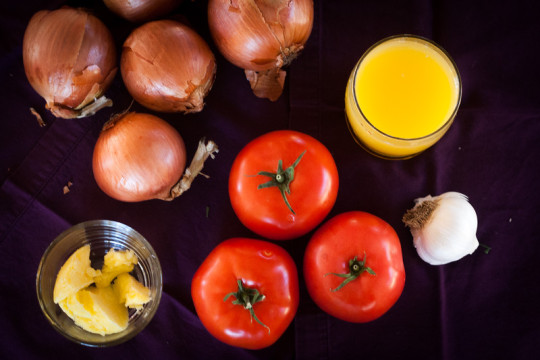
So there are many aspects of this recipe that draw on Egyptian cooking practices that have been around for centuries (if not more). But the twist – the part I didn’t quite appreciate until recently – is the addition of a thick, intensely stewed tomato sauce in the mix. This technique wouldn’t have been possible before the tomato was introduced to Egypt. That’s is tricky to pin down but my best guess is that it happened in the 18th or 19th century.
Once the tomato was introduced, it became and remains a cornerstone of modern Egyptian cooking. Egypt’s basic tomato-based sauce techniques are so commonplace, in fact, that they rarely appear in cookbooks and only became obvious to me through lots and lots of conversations with home cooks. In other words, for all its historical basis, there is also something about this recipe that can’t be accessed through text because it simply doesn’t exist there. In this sense, it’s a perfect foil to the overly fussy classical Arabic of that other duck recipe.

Duck No. 2 (vernacular)
Roasted Duck, or What does duck taste like in Egyptian?
Compiled and adapted from the advice of the many wonderful cooks who shared their culinary knowledge with me
Ingredients:
1 tablespoon cardamom
5 pieces of mastic gum
5 onions, sliced thinly
1 duck
For the marinade:
3 tomatoes, skins removed and grated
1 tablespoon tomato paste
1 tablespoon clarified butter
2 tablespoons honey
1 cup of orange juice
Salt and pepper
More clarified butter for basting
Method:
Place the duck, cardamom, mastic, and onions in a large pot, cover with water and simmer gently for 45 minutes. Add water as needed, just enough to keep the duck immersed.
Meanwhile, make some “salsa” (a kind of tomato sauce, in this context). Combine the grated tomatoes, tomato paste, samna, honey, orange juice, and salt and pepper in a saucepan and mix well. Bring to a boil then lower heat to a simmer until it turns from something like this:

To something like this:
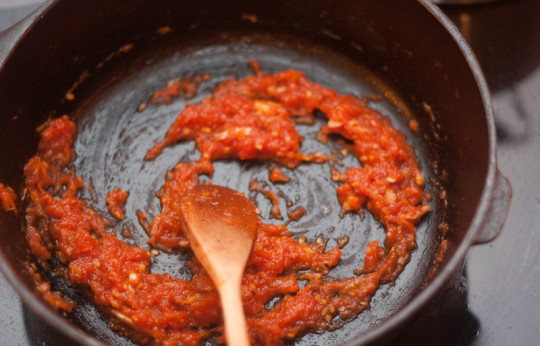
As it reduces, adjust the salt and pepper to taste.
Preheat your oven to 425 degrees Fahrenheit.
Once the duck is finished, carefully remove it and place it on a boiler pan, if you have one, or in any other kind of baking dish if you don’t.
Prick the bird in several places (this will let the fat and juices run out) and use a toothpick to pin the flap of flesh by the neck to the body of the bird, like so:

Next cover the bird as much as possible in the thick salsa (the orange and tomato marinade) and roast. After 15 minutes, baste in clarified butter and flip the bird over, applying additional marinade and clarified butter before cooking for an additional 15 minutes. Be sure to cook the bird to an internal temperature of 155 degrees F.
Since it was cooked partway in the pot, it shouldn’t need more than about thirty minutes in the oven. It should begin to brown all over. This is how mine looked, but I’ll admit I’ve seen ducks that were far more deeply browned, and next time I might try a little quick broiler action towards the end of the roasting process to see if I can achieve a similar effect. Regardless, this duck was quite tasty as is:
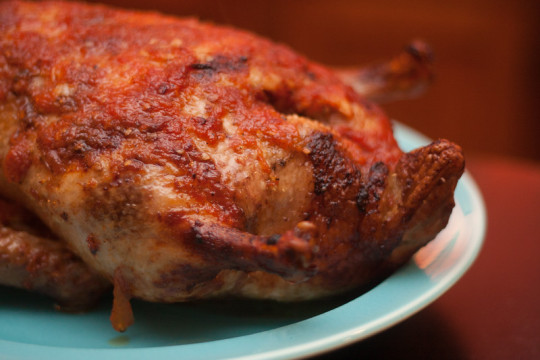
Let it rest, carve, and enjoy. You’ll end up with a duck that is succulent and just a little sweet; I suspect the thick tomato coating helps prevent the duck from drying out in addition to serving as a great butter and citrus delivery system.
And whatever you do, don’t throw away the broth that the duck was cooking in! I strain it to get rid of all the onions then freeze it to use as a base for future soups, stews, and risottos. Likewise, save those pan drippings and use them to season your cast iron cookware and add a little richness to your cooking.

So why the title of this post? I’ve been doing a lot of thinking lately about what cookbooks can and can’t do, and their limitations as a medium for transmitting culinary knowledge. There’s so much a cookbook can’t quite communicate about technique, judgement, flavoring and taste, when to stick to a tradition or pattern and when to innovate – all sorts of contingencies that are better communicated in person or in conversation, or learned through trial and error.
The first time I made this recipe I used a ready-made “salsa” in the form of tomato paste, woefully unaware of the range of approaches that Egyptian women use to concoct their own, fresher, better version. My appetite for the recipe was piqued by experiences eating duck in Egypt, from a family-owned restaurant in Luxor to the home of a friend. My understanding of the recipe is made up of dozens of phrases of advice offered to me by Egyptian home cooks: “boil with a lot of onion,” “season with cardamom and mastika,” or the way that the gamid (solid) that described the way a tomato sauce should look and feel corresponded with the sense of gamid as vigorous, robust, and solid the way that deep culinary knowledge ought to be.
Luxor: land of pigeon and duck
(Luxor: land of pigeon and duck)
I tried this recipe numerous times in attempts to reconcile all those experiences with my own practical culinary sense, adjusting the boiling time and embellishing the roasting technique with tips picked up from culinary authorities in my own culture, like Ina Garten.
This process is a remarkable contrast to the form of cookbooks written in mid-century Egypt. Those books were essentially an attempt to translate a particular ideology that dictated norms of rationalization, refinement, and nutrition, into recipes; and yet their practical function seems to have been much more along the lines of establishing forms of social distinction than preserving or transmitting culinary knowledge.
That’s not to say that all cookbooks work in the same way, of course. But it does draw attention to limitations that written recipes entail. In so many ways written recipes are like placeholders or signposts: the tip of the iceberg in terms of what it really takes to produce a meal. This is what I mean when I say that ideology never cooked a duck.
In Marxism and Literature, Raymond Williams wrote that “not only what is thought is being lived,” urging us to reconsider our received notions about knowledge and experience not by pitting “feeling against thought” but rather considering “thought as felt and feeling as thought.” What happens when we look beyond cookbooks to consider cooking in terms not only of culinary knowledge, but also culinary feeling: affective ties of hospitality and friendship, sensory memories, gestures witnessed and learned and re-learned?
Once we do accept the need to reconsider culinary practices in this way, it becomes even clearer what risks we run if we don’t: which histories and voices are neglected? What forms of labor, already likely un- or under-remunerated, are further undervalued? Food is a potent sphere for reclaiming space and thinking against dominant narratives, but that doesn’t mean it always works that way. For every duck recipe printed in a cookbook, surely there are thousands of ducks like these, simmering away in kitchens and off the page.
A roast duck recipe that's a microcosm of Egyptian culinary history – and a meditation on the limits of written recipes. #foodstudies #recipe #duck #Egyptianfood #المطبخـالمصري This is a follow-up to a couple of posts: it revises an Egyptian duck recipe I posted several years ago and it's the sequel to the…
#affect#cardamom#citrus#clarified butter#cooking as feeling#cooking Egyptian#culinary knowledge#culinary materialism#duck#Egyptian food#emotion#historical cooking#historical recipes#home cooking#home cooks#ideology#Marxism and Literature#mastic gum#orange juice#Raymond Williams#samna#tomato#tomato sauce#waterfowl
5 notes
·
View notes
Text
seven centuries of bstila
Bstila: food for the gods from Morocco + seven centuries of #foodhistory in a single bite. . . #recipe #historicalrecipes #foodhistory #foodstudies #Morocco #bstila #bstilla #pastilla #البسطيلة #المطبخـالمغربي #المغرب
Claudia Roden calls it “one of the great dishes of Morocco” and “food for the gods.” Traditionally stuffed with pigeon (now more frequently made with chicken), bstila is a pastry that blends salty and sweet, cinnamon and cilantro. It’s the kind of dish that you can read like an archival document, and its rich history merits a close reading.
Skip directly to the recipeor keep reading for more…
View On WordPress
#al-Tujibi#almonds#Black Morocco#chicken#cilantro#cinnamon#Claudia Roden#eggs#fes#filo dough#ginger#Marquis of Bute#medieval Arabic cookery#Moorish Recipes#parsley#pastry#pigeon#race#recipe#Reconquista#saffron#savory pastry#savory tart#slavery#sweet and salty#Tetouan#Zette Guinaudeau#المغرب#الأندلس
0 notes
Text
What does duck taste like in fuṣḥā?
What does #duck taste like in fuṣḥā? My latest foray into #historiccooking #Egypt #AblaNazira
If you follow me on Instagram then you may be aware that this year for Thanksgiving, I subjected my family to a culinary experiment as part of my dissertation research. It involved simultaneously cooking two very different recipes for duck, Egyptian style: one written in formal Arabic (fusha, pronounced FOOS-ha) and the other part of an oral tradition in many Egyptian families. Today I’m blogging…
View On WordPress
#Abla Nazira#apples#applesauce#Arabic language#book shopping#cairo#clarified butter#cookbooks#cooking history#culinary experiments#culinary history#diglossia#duck#duckglossia#Egyptian comedy#Ezbekiyya#Faisal Nada#French mother sauces#Gloucestershire#historical recipes#lemon zest#nutmeg#onions#recipe theory#recipes#roux#samna#Sauces#stuffing#thyme
0 notes
Text
red cabbage salad (for when enticing colors are desired)
Red cabbage salad, for when enticing colors are desired: #recipe with #feta, #lemon & #dates
This is not, strictly speaking, a recipe from the Middle East or North Africa. But I do use it to balance a meal in ways inspired by the traditions of medieval Arab cookery, in which presentation and color were key elements for setting a sumptuous table.
It’s a simplified version of a Smitten Kitchenrecipe, and one of my favorite kinds of dishes: the key lies in the combination of a few unlikely…
View On WordPress
#colors#dates#feta cheese#lemon juice#Lilia Zaouali#medieval Arabic cookery#narcissus#olive oil#purple cabbage#recipe#red cabbage#salad#the senses
0 notes

